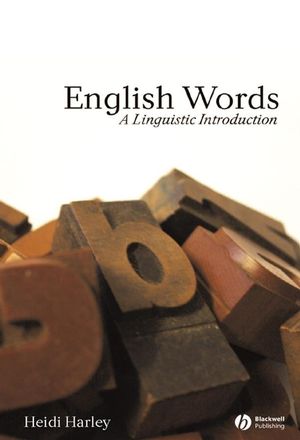English Words: A Linguistic IntroductionISBN: 978-0-631-23031-1
Hardcover
314 pages
May 2006, Wiley-Blackwell
 This is a Print-on-Demand title. It will be printed specifically to fill your order. Please allow an additional 15-20 days delivery time. The book is not returnable.
Other Available Formats: Paperback
|
||||||
Acknowledgments.
IPA Transcription Key.
1. What is a word?.
1.1 Explaining word in words.
1.2 Language is a secret decoder ring.
1.3 Wordhood: the whole kit and caboodle.
1.4 Two kinds of words.
1.5 The anatomy of a listeme.
1.6 What don’t you have to learn when you’re learning a word?.
1.7 A scientific approach to language.
2. Sound and fury: English phonology.
2.1 English spelling and English pronunciation.
2.2 The voice box.
2.3 The building blocks of words I: Consonants in the IPA.
2.4 Building blocks II: Vowels and the IPA.
2.5 Families of sounds and Grimm’s law: a case in point.
3. Phonological words: Calling all Scrabble players!.
3.1 Guessing at words: The Scrabble problem.
3.2 Building Blocks III: The Syllable.
3.3 Phonotactic restrictions on English syllables.
3.4 From a stream of sound into words: Speech perception.
3.5 Syllables, rhythm, and stress.
3.6 Using stress to parse the speech stream into words.
3.7 Misparsing the speech stream, mondegreens and allophones.
3.8 Allophony.
3.9 What we know about phonological words.
4. Where do words come from?.
4.1 Getting new listemes.
4.2 When do we have a new word?.
4.3 New words by ‘mistake’: back-formations and folk etymologies.
4.4 New words by economizing: clippings.
4.5 Extreme economizing: acronyms and abbreviations.
4.6 Building new words by putting listemes together: affixation and compounding.
4.7 Compounding clips and mixing it up: Blends.
4.8 New listemes via meaning change.
4.9 But are these words really new?.
5. Pre- and suf-fix-es: Engl-ish Morph-o-log-y.
5.1 Listemes.
5.2 Making up words.
5.3 Affixal syntax: Who’s my neighbor?, Part I.
5.4 Affixal phonology: Who’s my neighbor? Part II.
5.5 Allomorphy.
5.6 Closed-class and open-class morphemes: Reprise.
6. Morphological idiosyncrasies.
6.1 Different listemes, same meaning! Irregular suffixes.
6.2 Root irregulars.
6.3 Linguistic paleontology: fossils of older forms.
6.4 Why some but not others?.
6.5 How do kids figure it out?.
6.6 Representing complex suffixal restrictions.
6.7 Keeping Irregulars: Semantic clues to morphological classes.
6.8 Irregulars III: Suppletion.
6.9 Keeping Irregulars: Producing words on the fly.
6.10 Productivity, blocking and Bushisms.
7. Lexical semantics: The structure of meaning, the meaning of structure.
7.1 Function meaning vs. Content meaning.
7.2 Entailment.
7.3 Function words and their meanings.
7.4 Content words and their meanings.
7.5 Relationships and Argument Structure: Meaning and grammar.
7.6 Argument Structure.
7.7 Derivational morphology and argument structure.
7.8 Subtleties of argument structure.
7.9 Function vs. content meanings: the showdown.
7.10 How do we learn all that?.
8. Children learning words.
8.1 How do children learn the meanings of words?.
8.2 Learning words for middle-sized observables.
8.3 When the basics fail.
8.4 Morphological and syntactic clues.
8.5 Learning words for non-observables.
8.6 Syntactic frames, theta roles and event structure.
8.7 Agent-Patient Protoroles.
8.8 Functional listemes interacting with content listemes.
8.9 Simple co-occurrence? Or actual composition?.
8.10 Yes, but where do the words come from in the first place?.
9. Accidents of history: English in flux.
9.1 Linguistic change, and lots of it.
9.2 Layers of vocabulary and accidents of history.
9.3 A brief history of England, as relevant to the English vocabulary.
9.4 55 B.C. to 600 A.D. : How the English came to England.
9.5 600-900 A.D. The English and the Vikings.
9.6 1066-1200: Norman Rule.
9.7 1200-1450: Anglicization of the Normans.
9.8 1450-1600 The English Renaissance.
9.9 1600 -1750: Restoration, Expansion.
9.10 1750-modern day.
9.11 The rise of prescriptivism: How to really speak good.
9.12 English orthography: The Roman alphabet, the quill pen, the printing press and the Great Vowel Shift.
9.13 Summary.
List of Works Consulted.
Glossary.
Words Consulted.
Index.



